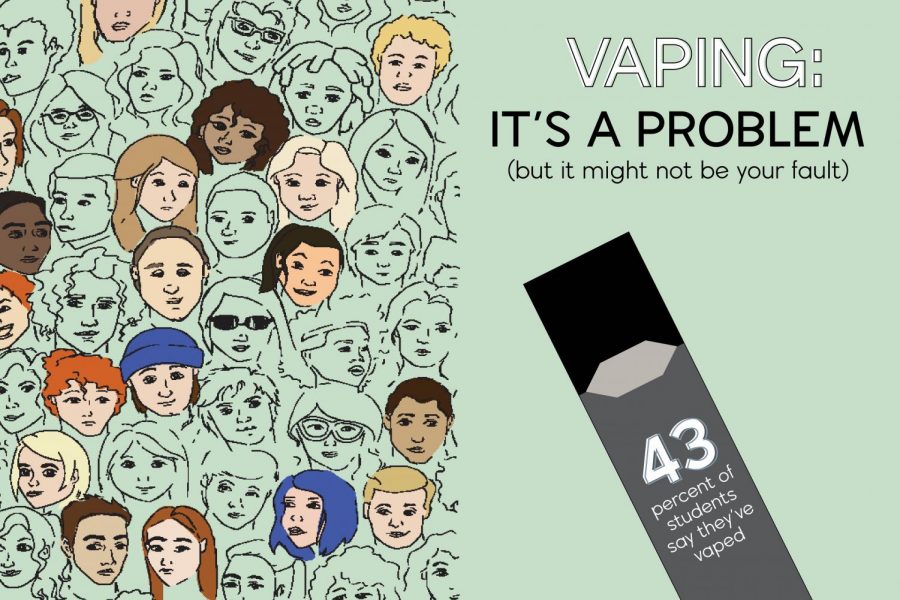By Annie Myers, Anika Roy and Anna Owsley
Food and Drug Administration-issued restrictions on e-cigarette companies elicits mixed reactions
The FDA is attempting to eliminate vaporizer advertisements targeted to youth to reduce prevalence of vaping
November 15, 2018
As you walk into the bathroom, you’re suddenly hit with the scent of mango. You draw back before realizing that the smell is coming from a stall, and someone is vaping in the middle of the period. It’s an all-too-familiar situation in schools across the nation, leading the Food and Drug Administration to take steps to stop the rise in vaping.
So, just how common is underage vaping? In a survey of 281 students, 43 percent said they have used a vape like one described above, while 22 percent said they have used one in school, whether it’s in the bathroom, in class, at the games or in the halls.
Because the FDA believes the marketing of vape has increased its popularity among youth, it has restricted the sale of flavored products at retail locations. The FDA has also banned any and all vape advertising targeted towards youth. In response, JUUL will be pulling flavored pods from stores and is limiting their online presence.
In a press release from Wednesday, Sept. 12, FDA commissioner Scott Gottlieb identified vaping as “nothing short of an epidemic” due to the nicotine content and prevalence among youth.
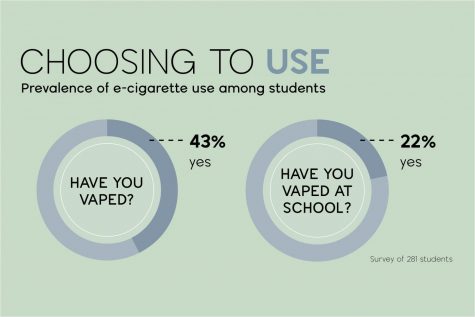 “The FDA won’t tolerate a whole generation of young people becoming addicted to nicotine as a tradeoff for enabling adults to have unfettered access,” Gottlieb said.
“The FDA won’t tolerate a whole generation of young people becoming addicted to nicotine as a tradeoff for enabling adults to have unfettered access,” Gottlieb said.
While 66 percent of students said they also believed the marketing of such products is targeted towards teenagers, the FDA’s actions and the rise in underage vaping have elicited mixed reactions from students, faculty and the community.
Marketing
Students and community attribute popularity of vapes to different aspects of marketing
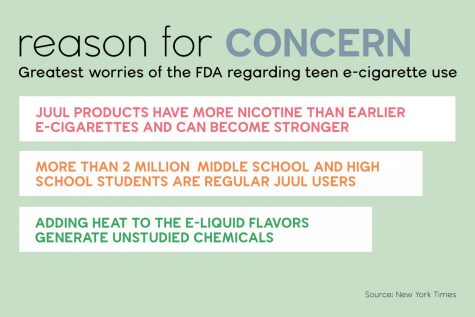
The usage of vape products has increased by 780 percent from 2011, according to the Truth Initiative. Nathan Wells, owner of Vapor Generation LLC, attributes the rise to vapes to adults using them as a replacement for smoking, as opposed to youth dependence.
“The main attraction to vaping has been how well it replicates smoking. It satisfies oral fixation as well as nicotine cravings … two of the main reasons of why people smoke,” Wells said via email. “It has more potential to switch former smokers to a less harmful alternative than anything else on the market.”
So, despite the FDA’s action, Wells believes his business will remain largely unaffected.
“Contrary to popular opinion, [the FDA’s restrictions] wouldn’t have a large impact,” Wells said. “I do agree that there should be some sort of restriction on how the product is portrayed. [Manufacturers should] present the product in a professional manner in order to portray an adult oriented product, which most producers already do.”
However, according to one sophomore female, who requested anonymity because she is under the age of 18 and has vaped in school, the design of the devices is meant to target teenagers specifically.
“Juuls and [other e-cigarettes] are so easy to hide and the only people who need to be hiding them are people who [can’t use them legally],” the female said. “I think the easiness of them to be hidden is targeted towards teens and the fruity tastes of pods is targeted towards teens too.”
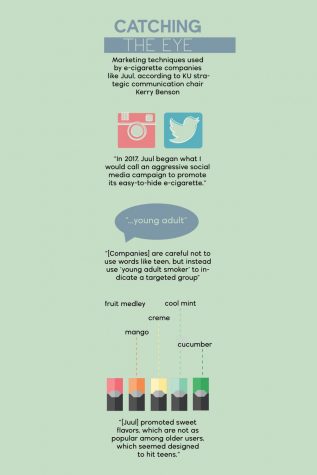 As for the methods of advertising, Kerry Benson, Strategic Communications chair at the William Allen White School of Journalism and Mass Communications at the University of Kansas, agrees that e-cigarettes and vape products have shifted towards targeting teenagers through social media.
As for the methods of advertising, Kerry Benson, Strategic Communications chair at the William Allen White School of Journalism and Mass Communications at the University of Kansas, agrees that e-cigarettes and vape products have shifted towards targeting teenagers through social media.
“[Vapes are] easy to hide, less intrusive in any setting and [they have] a modern vibe — even the vapor is ‘cooler’ than traditional smoke. In 2017, Juul began what I would call an aggressive social media campaign to promote its easy-to-hide e-cigarette,” Benson said via email. “It promoted sweet flavors, which are not as popular among older users, which seemed designed to hit teens. I think it’s a play for teens because your grandma probably isn’t as heavy a user of social media as most teens and she probably isn’t looking for snickerdoodle taste in a vape. It ain’t g-ma hittin’ Instagram and Snapchat several times a day.”
Though the marketing techniques play a role in the prevalence of vapes, the anonymous sophomore female believes that it is more common due to the current popularity of the product, with teenagers just wanting to follow the trend.
“[Students] buy one because they see other kids have it or they will hit someone else’s and then they are like ‘oh, I really like this, I want one for myself so I can do it whenever I want’ and they go and buy one,” the female said.
On the other hand, Wells believes the demand for vape in itself is what increased its popularity, even if he is for some marketing restrictions.
“The vaping market has had to use very little marketing to grow the industry to what it is today. The main reason is that these are products that smokers will seek out in a never-ending quest to quit,” Wells said. “Anyone, like myself, who has been unable to quit with traditional methods, is willing to give vaping a try. I am in favor of sensible regulations on social media such as flagging content for adults only.”
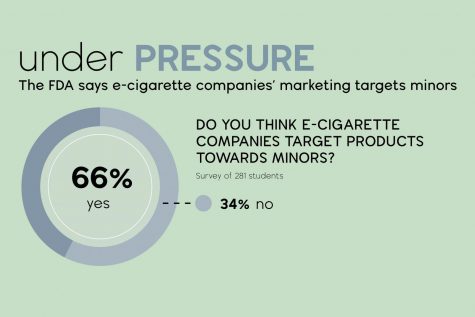 Ultimately, Benson foresees the FDA’s warnings will lead to advertisements shifting from overt to more restrained.
Ultimately, Benson foresees the FDA’s warnings will lead to advertisements shifting from overt to more restrained.
“Probably [as] much as [the] traditional promotion of old-school cigarettes shifted from blatant to more subtle, including different word choices in the ads,” Benson said. “It will shift with the language teens are already using as code for vaping. Teens will show marketers the path. All marketers need to do is pay attention to subtle cultural shifts.”
Purpose
Community attributes popularity of vape to different sources
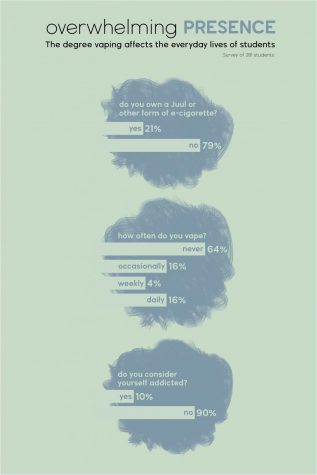 While marketing may play a role in the start to the popularity of vapes, the reasons as to why it is still so prevalent is disputed.
While marketing may play a role in the start to the popularity of vapes, the reasons as to why it is still so prevalent is disputed.
From principal Tobie Waldeck’s perspective, the products are so common because they are especially accessible to teenagers, even though they are illegal for minors.
“I think [the causes are] access, availability and the ease of doing it. To me, it’s a national problem,” Waldeck said. “I was at another high school somewhere, which I will not name. I got out of my truck, looked down, vape, right there. It’s everywhere … So, I think availability is a part of it. Kids are doing it younger and younger, and it’s an issue.”
For one senior male, who is anonymous because he is under 18, vaping is a way to unwind.
“It helps me feel more relaxed,” he said. “I’ve felt that I’ve been a more likeable person since I’ve started doing it. It makes me act just more relaxed, more mellow. It’s another constant, and if things are changing around you, a thing that stays constant can be helpful.”
However, for the sophomore female, vaping isn’t a choice anymore.
“I’m addicted and it sucks. I feel like everyone at Mill Valley knows that Juuling is bad, I’ve heard a lot of people say they are going to quit. But, once you start to quit … you feel the need for the nicotine more,” the female said. “One time, I started crying because my ex-boyfriend wouldn’t let me hit his Juul … and some people get really pissed off if they don’t have the nicotine.”
She isn’t alone: 10 percent of students out of the 281 surveyed have said they were addicted to vaping. According to the sophomore female, the effects of the nicotine content have hugely impacted how often she vapes.
“It just feels like you have a need to hit it, like all of the time. It’s uncontrollable and it’s like [it’s] taking over your brain,” she said. “It’s like a really bad craving. I couldn’t focus in English [one time] because the kid who sits across from me wouldn’t let me hit his. It was awful.”
For school resource officer Mo Loridon, a belief that vapes are safer options for students is a large contributor to their popularity as well.
“I often hear people say that it is better than smoking cigarettes. Well, it may be a little better than smoking cigarettes, that doesn’t mean it is good for you. We just don’t know if it’s harmful or not yet,” Loridon said. “It is still a status thing. I think students and young adults just think it is the hip, cool thing to do. It helps that it tastes good and it has the misconception that it is not a big deal.”
The unknown chemicals present in vape products make them a questionable product according to Johns Hopkins Medicine, which states that “many e-cigarette users get even more nicotine than they would from a tobacco product.”
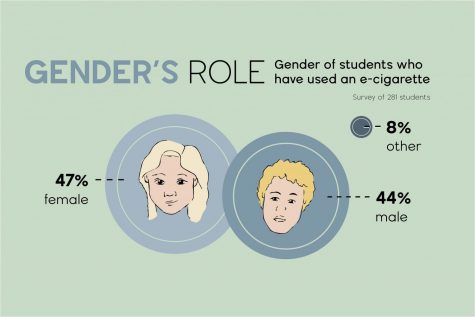
However, the perceived health benefits in comparison to other tobacco products are part of the reason why the senior male uses them, as well as casual fun.
“I think vaping is a lot healthier than cigarettes. Not to say vaping is healthy, because it’s not … but, if I am going to harm my body, I want to take some precautions,” he said. “[It’s] partly because I just kind of enjoy it. There’s a buzz. Your body just kind of feels tingly and relaxed. The feeling of the vapor in your mouth and blowing it is enjoyable. Vape tastes good.”
Consequences
Vape products have numerous health, legal and school consequences for youth
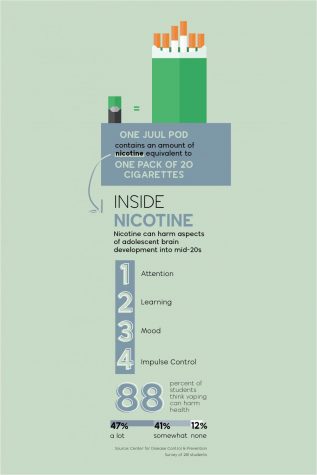 While the FDA’s efforts to regulate marketing are meant to help decrease teen dependence on vape products, the school also enforces punishments to curtail the prevalence of vapes. The nicotine content in vapes is what dictates the consequences, according to Loridon.
While the FDA’s efforts to regulate marketing are meant to help decrease teen dependence on vape products, the school also enforces punishments to curtail the prevalence of vapes. The nicotine content in vapes is what dictates the consequences, according to Loridon.
“The vapes I confiscated contain nicotine and the state law and the city ordinance of Shawnee states that nicotine is illegal for anybody under the age of 18,” Loridon said. “It is my job that, if you are breaking the law while at school, you get punished for it. It’s a big deal because it contains nicotine. We wouldn’t let students smoke cigarettes, we can’t let them vape.”
The punishment for vaping or other prohibited behaviors applies both on school and district grounds as well as school activities. It consists of three days of out-of-school suspension and potentially a ticket from the police department, if the user is underage. In the week of Monday, Oct. 22 alone, over 20 students were suspended for vaping at school.
When it comes to the penalties for using vapes at school, Waldeck believes students need to be aware of all the potential outcomes.
“I like to be open and upfront. If they’re caught vaping, the consequences are inevitable by policy,” Waldeck said. “It is my hope that they realize the dangers involved and refrain from doing so. We just want to make sure kids are safe and healthy.”
The dangers inherent in vape is partly why the anonymous girl believes it is not worth starting.
“Once you reach a certain point of addiction, you don’t even get buzzed anymore. You don’t get the effects to sustain yourself, so there is no point in starting it,” she said. “I think the adults need to realize that the majority of kids don’t like the fact that they have Juuls and stuff, and that [kids] are addicted and don’t want to be.”
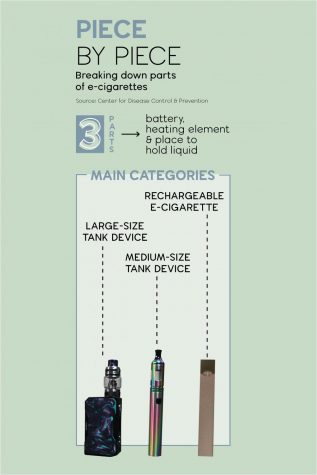 Loridon hopes students avoid vaporizers and e-cigarettes due to the lack of knowledge about the product itself, as well as what is in it.
Loridon hopes students avoid vaporizers and e-cigarettes due to the lack of knowledge about the product itself, as well as what is in it.
“What I want most students to know is that you don’t know what you are putting into your body. Not knowing what you are putting into your body should make you not want to do it,” Loridon said. “We had recently a student [who] found a vape and used it and shared the found vape … The first person didn’t know where it’s been and what’s in it and certainly neither does the second person, so how do we know for certain if there was any other drugs or bacteria or something completely disgusting?”
Despite the unknowns and the consequences, the senior male believes that punishments won’t stop those who vape.
“Honestly, I don’t think it’s going to change a thing. Whether it gets harsher or less harsh, it doesn’t matter because if [people] already behave one way, they’re going to continue behaving that way,” he said. “I don’t think punishment is really going to change that person’s mindset. If someone is going to get suspended, I can guarantee that they’re still going to use it at school ーat least some of them.”
However, the sophomore female believes that vapes will naturally phase out as students distance themselves from the negative effects.
“Kids now realize how bad it is for you. That’s why I’m trying to quit, because I know it’s bad for my health. It’s just hard,” she said. “I think within a couple months, people will be trying to stop. Everyone wants to. That’ll be a lot of people’s New Year resolutions.”
